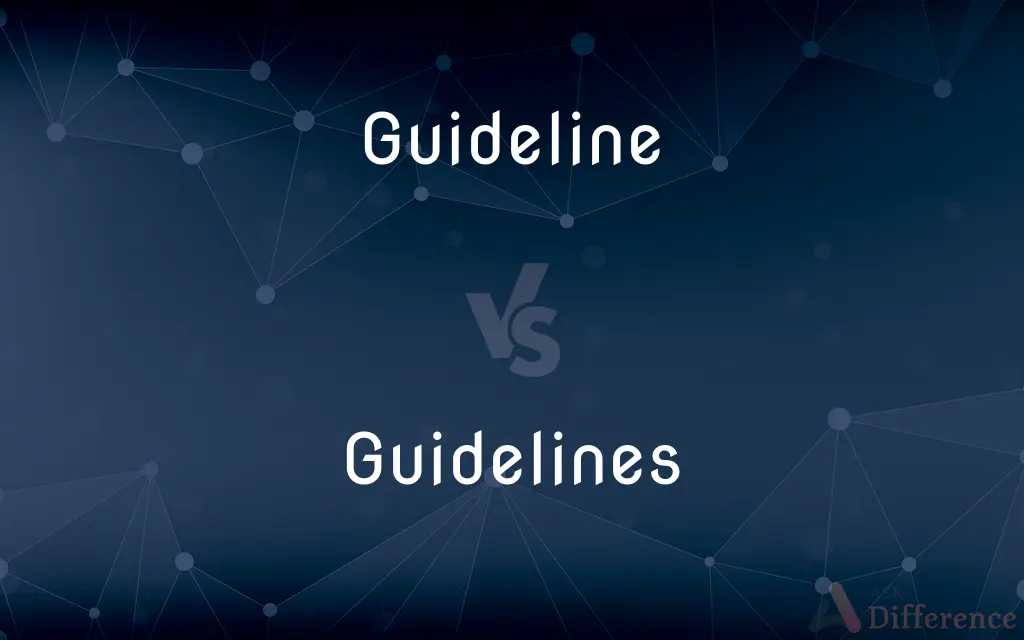Guideline vs. Guidelines — What's the Difference?
By Tayyaba Rehman & Fiza Rafique — Updated on April 4, 2024
A guideline offers general advice or direction, while guidelines consist of multiple recommendations or rules intended to guide actions.

Difference Between Guideline and Guidelines
Table of Contents
ADVERTISEMENT
Key Differences
A guideline typically refers to a single principle or directive that aims to guide decisions or procedures. It provides a broad framework for action, leaving room for discretion and interpretation. On the other hand, guidelines are a collection of multiple instructions, principles, or rules designed to steer actions or decisions in specific scenarios. They are often more comprehensive, covering various aspects of a topic or procedure.
While a guideline might be more general and applicable to a wide range of situations, guidelines are usually more detailed and tailored to specific contexts or fields. For instance, a guideline for writing might advise being clear and concise, whereas guidelines for writing research papers would detail formatting, citation styles, and structure. This distinction highlights how guidelines can offer more granular and specific advice compared to a single guideline.
The development of a guideline often involves synthesizing expert opinions or evidence to form a single best practice recommendation. In contrast, developing guidelines typically requires a more extensive process, involving the consolidation of many best practices, evidence-based recommendations, and consensus from multiple stakeholders. This makes guidelines particularly useful in complex fields like medicine, where multiple considerations and outcomes must be balanced.
In terms of application, a guideline serves as a singular reference point that can guide behavior or decisions broadly, without prescribing exact steps. Guidelines, however, provide a framework that is more prescriptive, detailing specific actions, thresholds, or criteria that should be followed in particular situations. This makes guidelines more actionable for those seeking to comply with best practices or standards within a specific domain.
The usage context also differs; a guideline can be a standalone recommendation applicable in various contexts, such as ethical guidelines in research, whereas guidelines are often compiled into documents or manuals specific to a field or activity, like safety guidelines in construction. This compilation reflects the comprehensive nature of guidelines, encompassing multiple areas of concern to ensure thorough guidance.
ADVERTISEMENT
Comparison Chart
Definition
A single principle or directive aimed at guiding decisions or procedures.
A collection of multiple instructions, principles, or rules.
Detail Level
General and broad, allowing for interpretation.
Detailed and specific, covering various aspects of a topic.
Development Process
Synthesizes expert opinions or evidence into a best practice recommendation.
Consolidates many best practices and recommendations from multiple stakeholders.
Application
Serves as a broad reference point for behavior or decisions.
Provides a detailed framework for specific actions or criteria.
Usage Context
Can be applied in a wide range of situations.
Often compiled into field-specific documents or manuals.
Compare with Definitions
Guideline
To offer general direction or advice.
One health guideline is to engage in physical activity regularly.
Guidelines
To ensure consistency and safety in practices.
Safety guidelines in the workplace reduce the risk of accidents.
Guideline
Often based on expert consensus or evidence.
The dietary guideline emphasizes eating more fruits and vegetables.
Guidelines
More prescriptive, with specific instructions to follow.
The guidelines for manuscript submission detail formatting requirements.
Guideline
Broad and not specific to any one situation.
Reduce, reuse, recycle to protect our planet.
Guidelines
Involves detailed research and consensus from multiple experts.
The guidelines for sustainable building draw on numerous studies.
Guideline
Allows for discretion in its application.
The guideline for project management is adaptable to team size.
Guidelines
Tailored to particular fields or activities.
The clinical guidelines for treating hypertension outline various medication options.
Guideline
A singular directive aimed at influencing decisions or actions.
The guideline suggests limiting daily screen time for children.
Guidelines
A set of rules or principles designed to direct actions in specific scenarios.
The guidelines for emergency evacuation are posted in every classroom.
Guideline
A guideline is a statement by which to determine a course of action. A guideline aims to streamline particular processes according to a set routine or sound practice.
Guidelines
A statement or other indication of policy or procedure by which to determine a course of action
Guidelines for the completion of tax returns.
Guideline
A statement or other indication of policy or procedure by which to determine a course of action
Guidelines for the completion of tax returns.
Guidelines
Plural of guideline
Guideline
A non-specific rule or principle that provides direction to action or behaviour.
He considered the Ten Commandments more as a guideline than a requirement.
Guidelines
A rule or set of rules giving guidance on how to behave in a situation.
Guideline
A plan or explanation to guide one in setting standards or determining a course of action.
Guideline
A light line, used in lettering, to help align the text.
Guideline
A formal rule describing how a situation must be handled; - used as a direction to administrators from superiors.
Guideline
A light line that is used in lettering to help align the letters
Guideline
A detailed plan or explanation to guide you in setting standards or determining a course of action;
The president said he had a road map for normalizing relations with Vietnam
Guideline
A rule or principle that provides guidance to appropriate behavior
Common Curiosities
Can guidelines be flexible?
While guidelines are more prescriptive than a single guideline, they may offer some flexibility in application, depending on the context.
How are guidelines developed?
Guidelines are developed through extensive research, expert consensus, and often public consultation to ensure they are comprehensive and evidence-based.
What is the difference between a guideline and guidelines?
A guideline is a single directive offering general advice, whereas guidelines are a collection of specific rules or instructions for particular scenarios.
How often are guidelines updated?
Guidelines are updated regularly to reflect new evidence, technologies, and practices, ensuring they remain relevant and effective.
Can guidelines vary by region or country?
Yes, guidelines can vary significantly due to regional differences in practices, regulations, and available resources.
How should one follow guidelines?
Guidelines should be followed as closely as possible to ensure the intended outcomes, though some discretion may be applied based on professional judgment.
What happens if guidelines are not followed?
Not following guidelines can lead to inconsistent practices, lower quality outcomes, and in some cases, legal or professional repercussions.
Why are guidelines important in professional settings?
Guidelines ensure consistent, safe, and effective practices across various professional fields, especially in areas where precision and safety are paramount.
How do guidelines support decision-making?
Guidelines provide a structured framework for making informed decisions, especially in complex or specialized areas.
Are guidelines legally binding?
While some guidelines may have a regulatory or legal basis, many serve as recommendations and are not legally binding.
Can a guideline become part of guidelines?
Yes, a general guideline can be incorporated into a set of guidelines as one of many recommendations to provide broader guidance.
Are guidelines applicable to all industries?
While the concept of guidelines is applicable across industries, the specific content and focus vary greatly depending on the field.
Who is responsible for creating guidelines?
Guidelines are usually created by governing bodies, professional associations, or expert committees within specific fields.
How can one access professional guidelines?
Professional guidelines are often published by industry associations, regulatory bodies, or academic institutions and are available on their websites.
Why might guidelines be criticized?
Guidelines might be criticized for being out of date, too rigid, not applicable in all contexts, or influenced by conflicts of interest.
Share Your Discovery

Previous Comparison
Grift vs. Graft
Next Comparison
Squire vs. KnightAuthor Spotlight
Written by
Tayyaba RehmanTayyaba Rehman is a distinguished writer, currently serving as a primary contributor to askdifference.com. As a researcher in semantics and etymology, Tayyaba's passion for the complexity of languages and their distinctions has found a perfect home on the platform. Tayyaba delves into the intricacies of language, distinguishing between commonly confused words and phrases, thereby providing clarity for readers worldwide.
Co-written by
Fiza RafiqueFiza Rafique is a skilled content writer at AskDifference.com, where she meticulously refines and enhances written pieces. Drawing from her vast editorial expertise, Fiza ensures clarity, accuracy, and precision in every article. Passionate about language, she continually seeks to elevate the quality of content for readers worldwide.














































